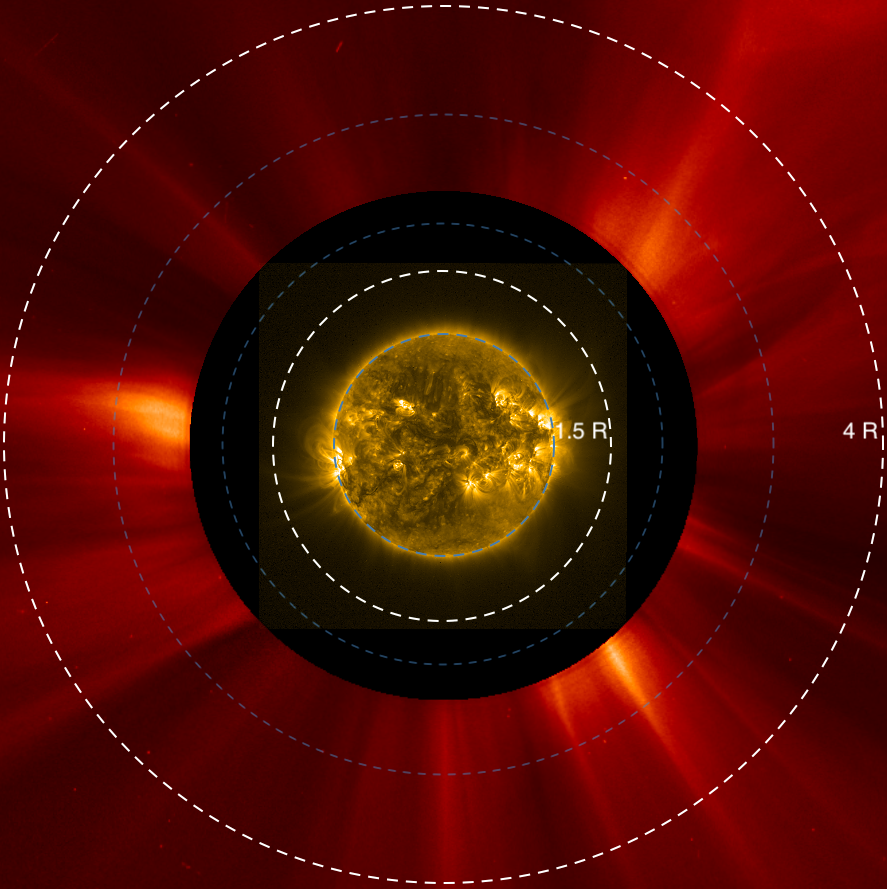The Middle Corona Forum |
| Forum Links |
| Introduction |
| The Middle Corona Paper |
| Instruments |
| Observations |
| Phenomena |
| Models |
| Outreach Material |
| News |
| Links |
| Instrument Tex |
| Tools |
| Contact |
| Disclaimer |
| Home Page |
| Tweets by MiddleCorona |
For a comprehensive overview of the region please read The Middle Corona Definitional Paper, which can be found here: The Middle Corona Definitional Paper.
How we define, confine and quantify the Middle Corona has been discussed for several years, as with most regions of the solar atmosphere, due to the range of temperatures, densities, magnetic field strengths and energetics that pervade it. Potential definitions include:
The lower corona has long been considered the region above the chromosphere and out to the edge of our EUV/X-ray imager Field of View (FOV), or to a point where the image compression / emission is too low for structures to be distinguished from the background noise, which can be roughly considered at 1.5 RSun.
The heliosphere is the region of the solar atmosphere encompassing the solar system out to the heliopause, where the solar-wind, a stream of charged particles released from the upper atmosphere of the Sun, dominates. The solar wind is embedded with an interplanetary magnetic field (often referred to as the open field) generated, and extending, from within the Sun. The lower boundary of the heliosphere can be considered the region where we transition from a predominately magnetic dominated environment to a thermally dominated environment. This transition is roughly located between 1.5–6 RSun, but of-course can be lower (e.g. coronal hole regions), or higher with other coronal structures. Although, we note that this is not constant throughout the solar atmosphere, and varies with the period of the solar cycle.
Figure 1. Shows a SWAP-EUV image, combined with a LASCO-C2 coronagraph white-light image. The Field of View (FOV) extends from solar disk centre to approximately 6 RSun. The blue-dashed circles are separated by 1 RSun intervals, highlighting distances from 1 to 6 RSun. The white dashed lines, highlight the distances 1.5 RSun and 6 RSun, which roughly defines the Middle Corona.
The point to take away from this discussion is that the region is somewhat arbitrarily defined, as with all regions of the solar atmosphere, and therefore open to debate. Although we have defined 1.5–6 RSun as the region of interest. The Middle Corona is heavily influenced by the magnetic structures from below, and from dynamics above, and cannot be considered as a separate entity. And is therefore largely defined by our lack of observations of the region.

Why hasn’t the middle corona been better observed?
Why do we need to study the middle corona?
Several images and movies were created using the ESA and NASA funded Helioviewer Project.
LASCO Images courtesy of SOHO/LASCO consortium. SOHO is a project of international cooperation between ESA and NASA.
SWAP Images courtesy of PROBA2/SWAP consortium. PROBA2 is a project of the Centre Spatial de Liège and the Royal Observatory of Belgium funded by the Belgian Federal Science Policy Office (BELSPO) and ESA.
The Middle Corona Forum, to discuss all things Middle Corona.
Disclaimer: This website contains links to external websites that are not provided or maintained by us. We do not guarantee the accuracy, relevance, timeliness, or completeness of any information on these external websites.
Please note that we do not have any control over the content and availability of these exte rnal sites. The inclusion of any links does not necessarily imply a recommendation or endorse the views expressed within them.
If you find any content on external websites that is offensive, illegal, or violates our policies, please contact us and we will take appropriate action.